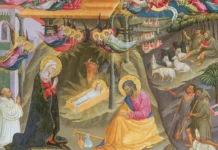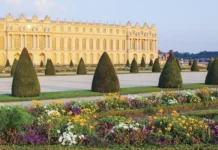In contemplating the Child Jesus, Our Lady’s affection for Him was full of admiration, considering Him firstly as God, and secondly in His human frailty.
As we meditate on the relationship of Mary Most Holy with her Divine Son, still a child, let us consider her adoration, as a creature, towards her God and Creator and, at the same time, the affection of that heavenly Mother towards her only and incomparable Son.
Admiration is the foundation of love
Being a model of humility, Our Lady would not approach the Infant-God until She had shown Him all the respect and admiration that He deserved. Knowing that her Son was, as a creature, the crowning-piece of Creation, She could not have failed to place herself in a humble position before the Saviour.
The highest of creatures is so infinitely below the Creator that She can speak to Our Lord as if She were the last. For example, if a person were to imagine himself closer to the Sun because he measured ten centimetres more than the average man, we would laugh, for such is the distance between the Earth and the Sun that we could well ask: what is ten centimetres in comparison with it?
As God is infinite, even the immense distance that separates Our Lady from all of us is small as compared with the distance that separates Her from Our Lord.
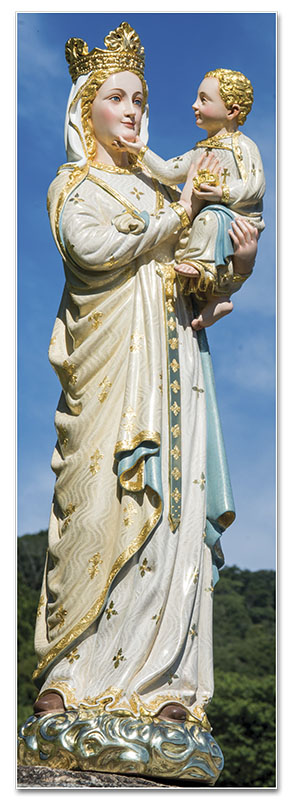
Turris Eburnea House, Caieiras (SP)
Thus we can understand the series of acts of humility which She practised in the presence of the Child Jesus. These were not based on egocentric but on theocentric considerations. Our Lady did not say “I am the last of creatures,” but had in mind, more than her own dependency, the infinite grandeur of God. For this reason, her manifestations of affection began with acts of admiration.
There is a logical order in this which deserves a brief comment. When we love someone very much, we should begin by admiring the person. For admiration is the foundation of true love.
The Most Holy Virgin had before Her the One who, as man, was the most admirable of all creatures; and as Man-God, hypostatically united to the Second Person of the Most Holy Trinity, was infinitely superior to all things. There are no words to describe the admiration that this deserves, or to sufficiently express the love that it elicits, for it flows from admiration.
Contemplating the infinite grandeur of God in the fragile Child
Evidently, Mary’s reasons for loving her newborn Son went far beyond the fact that He was beautiful and charming. Such considerations have their rightful role, but they are not the main ones. Many people imagine that Our Lady looked at the Child Jesus and said: “What a lovely little doll!” However, this would definitely not be on a par with the circumstances.
The Mother of God knew, by divine revelation made directly to Her, that the Son begotten in Her was the Second Person of the Most Holy Trinity. Therefore, her amazement at seeing Him for the first time was as follows: “So weak and so tiny, yet He is God, in His infinite grandeur and unfathomable admirableness. God is there!”
Her thoughts ascended to the Most High, considering all of his greatness, and then turned to the Child. In this way She was able to measure the distance between the One and the Other, the profound significance of the hypostatic union and the torrents of glory that flows from this union down upon that Child. Only after this did She analyse Him with the affection of a mother and see the sun of God reflected in His gaze. It was then that the maternal tenderness emerged for the tiny Child.
Admiration and affection: two correlated attitudes of soul
Nevertheless, admiration does not disappear at this moment to give way to pure affection, for if it were to die, the affection would also die, just as when affection dies so too does admiration. They are two correlated attitudes of soul.
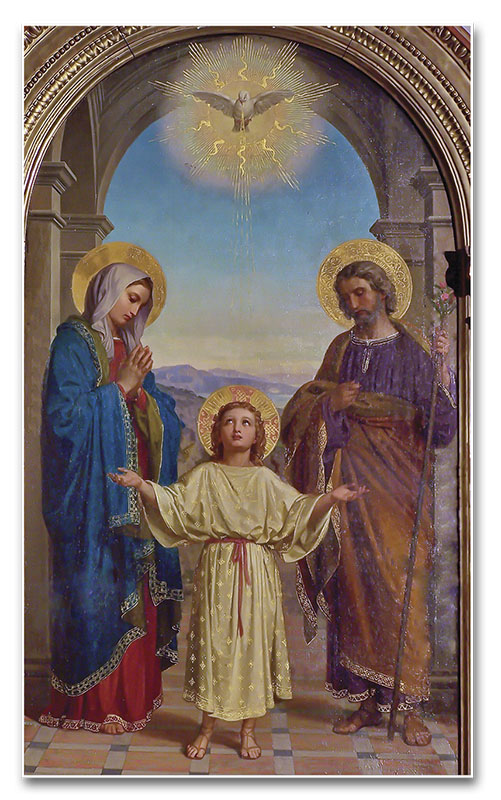
When a good mother has a baby, she feels tenderness for the child. But there should be, even in her subconscious, the following idea:
“What a wonderful thing it is for a creature to be called to lead a life of long duration, to fulfil serious obligations, such as those of fatherhood or motherhood, and above all the duties towards God: to be a good daughter or good son of the Catholic Church, to master one’s passions, to sanctify oneself and to go to Heaven for all eternity! This ‘Angel in progress’ that I see here, is something so extraordinary! How touched I am to see something so great contained in such a small body.”
When considering that this is her child, a great tenderness arises, but also a great admiration: “What a magnificent mystery by which I, a human creature, have begotten another human creature! How enigmatic and profound it is! He was born of me, he is being nourished by me, he was formed in my womb, I released him into life and here he is, so very small, so tiny… For him to exist, an immense mystery has taken place.”
To this mystery is added another: the exact moment when God, leaning down, as it were, over that embryo, “breathes” a soul into it, giving it something that the mother did not beget, nor did it come from the conjugal act, but was created directly by God. How magnificent!
The tenderness of a true mother, well oriented towards her child, must be intertwined with reflections like this. She gave birth to an “other self” which is flesh of her flesh and blood of her blood. Over this new being the Divine Holy Spirit hovered and infused a soul. The work of God was added to hers to give rise to something immensely greater.
With a soul, horizons are opened to that child! Horizons of struggle, of battle, of self-denial, or of joy and victory, in those days when one has the impression of touching Heaven with one’s hands. But there are also horizons of sadness, of discouragement and failure, which move us to ask God for the grace to forge ahead.
How a mother should regard her child
Thus another aspect of the birth of a simple child appears.
According to the Church, the life of every creature is comparable to that of a hero who uses exercise to prepare himself for the battle, and then, at the moment he is about to enter the arena, he stretches, applies aromatic oils and the like to condition all his muscles to confront the beasts he is going to fight, or the other gladiators against whom he will engage in combat.
When the time comes, he takes up his weapons, his shield, and enters the arena. Whoever were to look at such a hero waiting in the room of the gladiators, or of the animal tamers, and see him calmly seated, ready for the immense battle, could not help but admire him.
Now a child who enters the world is like that hero. It is on the verge of an immense battle. Whether a girl or a boy, if the mother has a true sense of things, she will say: “Warrior! I admire you because you are a fighter of the good fight! This is your duty. Once you receive Baptism, grace will call you. And from that moment on, a supernatural life will begin in you, like the fire one lights on a candle.”
The child is to his mother like a candle to be lit. She herself will bring him to the priest who will make the light of grace shine in his soul, a created participation in the life of God. She looks and says: “With how much intensity will this soul burn? What good will it do? How much glory will it give to God?”
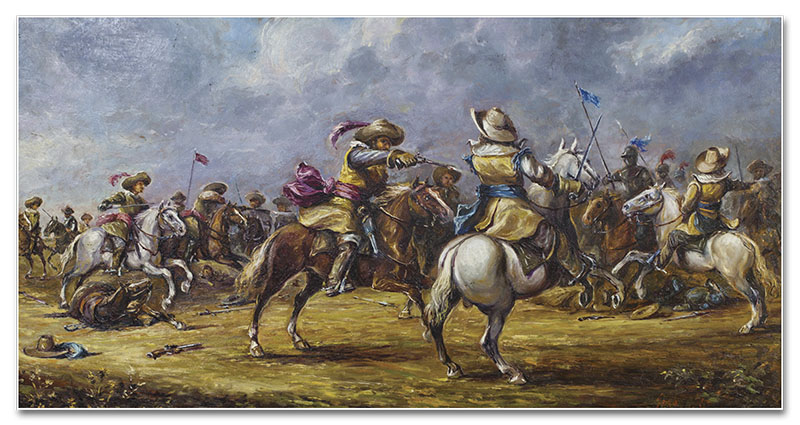
Taking the meditation to its final consequences
This is how a true mother should look at her child. But if she has the courage to carry her reasoning to the end, she cannot help but think: “Will this child not one day offend God? Will he not abuse God’s patience? Could it not be that God will unleash His wrath upon his person and he will go to hell? As a mother, who has prepared for him such a delicate and splendid cradle, how it pains me to think that he could be condemned to the pains of hell, where this little mouth that now cries would blaspheme against God for all eternity! And if I save myself, I from Heaven will see this little child, already grown up, blaspheming against God for all eternity! And I will say: ‘My God! Would it not have been better if he had not been born?’”
However, if she is a true mother, because she first knew how to be a true daughter of God, she will think differently: “If it should happen that this child of mine, despite my having prayed for him as St. Monica prayed for St. Augustine, should resist the influence of grace and be precipitated into hell, oh God, what a terrible fate! But if he has deserved Your eternal wrath, I, my God, will not detach myself from You: if You hate him, I will hate him too! And when he blasphemes against You in hell, and You curse him, I herewith add my mother’s curse to Yours. If he be Your enemy, he shall have me, his mother, as his enemy also.”
This would be the meditation of a mother taken to its final consequences.
Ineffable relationship between Mother and Son
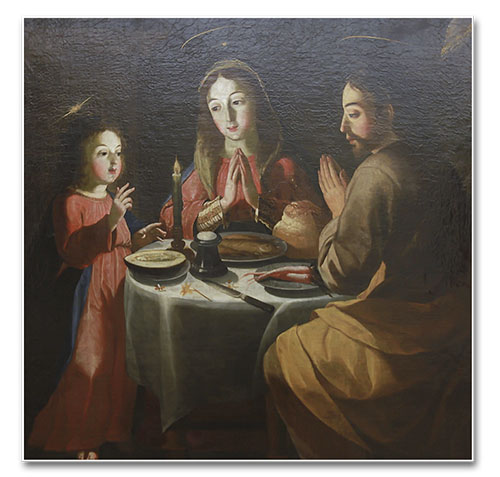
But, returning to the relationship between the Blessed Virgin and her Divine Son, let us consider what happened during the thirty years that Jesus spent in the house of Nazareth.
There Jesus witnessed the death of St. Joseph – proclaimed, with great accuracy and wisdom, by the Church, as the Patron of a Good Death, for one cannot die in better conditions than being assisted by Our Lady and by Jesus himself – and as a Son, cared for His Mother, who had become a widow.
We can imagine His conversations with Her when in the evening, at the end of the meal, they were alone, looked upon and truly loved one another, enjoying the enormous happiness of being together, conversing, exchanging thoughts, etc.
Our Lady, meditating on what would happen in the future, must have thought about the moment when the Angels would carry that holy house of Nazareth through the air so that it would not fall into the hands of the Mohammedans.
She knew that it was going to be set in a place called Loreto, and that countless numbers of pilgrims would worship there, probably until the end of the world, the holy walls within which those conversations had echoed. There the candid and crystalline laughter of the Child Jesus was heard; the grave, paternal and affectionate voice of St. Joseph; and that of the Virgin Mother resounded, modulated almost infinitely, like an organ, expressing adoration, veneration and tenderness in every degree and modality.
Mary Most Holy thought of the public life of Our Lord, of the miracles He would perform, of the souls He would attract, and of how all this would culminate in the rejection of the Jews and in the betrayal of Judas.
After Pentecost, the Church expanded throughout the entire Mediterranean basin. She saw, without a doubt, the unknown places where the Apostles would go, filling the earth with their presence, the liberation of the Church by Constantine, the brilliance she achieved on the face of the earth, the invasion of the barbarians… Later, St. Benedict would leave the swamp that Rome was at the time and flee to Subiaco, where a spiritual life begins from which the Middle Ages will be born.
Christendom would come, but the Revolution would begin: the Renaissance, Humanism, Protestantism, the French Revolution, the Communist Revolution… Upon all this, no doubt, She thought; and on all this we ought also to reflect when we are before the Nativity Scene, or contemplating an image of the Child Jesus. He is the rock of scandal that divides history. ◊
Taken, with minor adaptations, from:
Dr. Plinio. São Paulo. Year XIX.
N.214 (Jan., 2016); p.12-17



